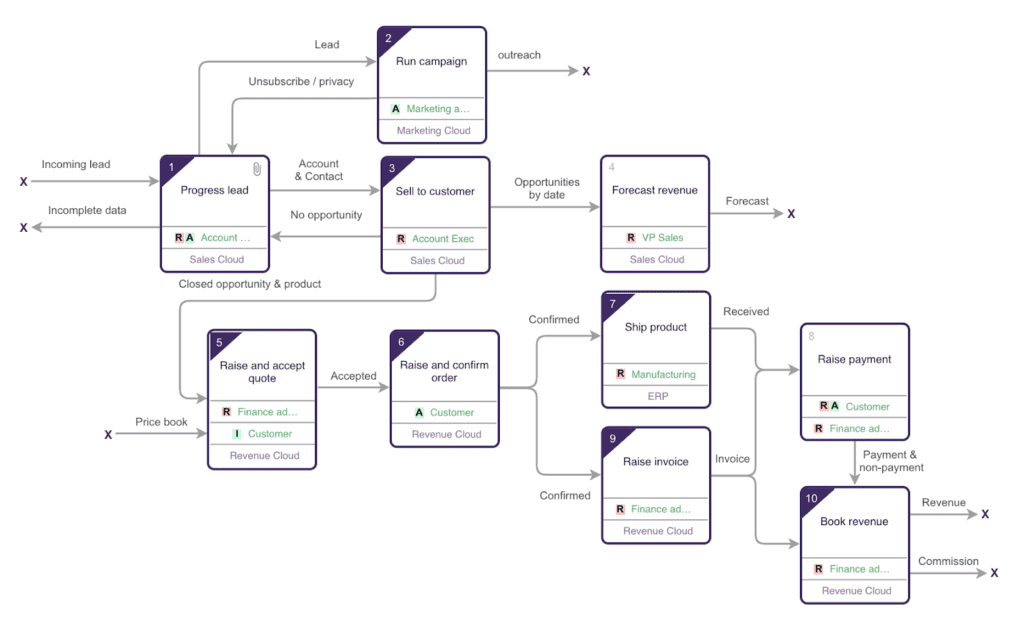
What is Universal Process Notation (UPN)
Successful companies tend to document the workflow and description of each crucial process to have a clear understanding of how the company runs in different departments. Analysis and business process improvement is a part of business process management. But before analyzing and improving them, the first step is the discovery. To do this, it is important to model a process using standard notation. Here we’ll talk about two notations – Business Process Notation (BPMN) 2.0. and Universal Process Notation (UPN).
Business Process Notation (BPMN 2.0) is a widely used process notation among managers, however, it requires time and effort to understand its syntax and logic. There are a couple of main objects within BPMN 2.0:
- Flow (event, activities, gateway),
- Connections (sequence, flow, association),
- Swimlanes (pool, lane), and
- Artifacts (data object, group, annotation).
To model with such a variety of different objects, there are common modeling rules to take into consideration. While this generally makes a process detailed but still visually organized, it also requires knowledge of understanding different gateway types, flow purposes, and activity features.
The image below shows the BPMN 2.0 complexity: given all object types in the notation, there are many different ways to model a process. Such notation requires extensive understanding of each symbol in order to understand how a process works.

source

source
While some would agree that the standard notation for model processes is BPMN 2.0, there is no specific notation that is officially recognized as a standard for notating models. The reason for that is that users/stakeholders with different competencies interpret these models – ranging from experienced process managers that use process notations regularly – to users that do not have experience with modeling or interpreting process notations. Such users would rather prefer, for example, flowcharts, but, those diagrams do not present all the needed information.
From our experience, many users need to analyze processes based on BPMN 2.0, but they do not have the knowledge or experience with it. Because of this, a new notation emerged, called Universal Process Notation (UPN).
Universal Process Notation (UPN) – easy to understand approach to process modelling
Universal Process Notation (UPN) helps in modeling (notating) a process in a standardized way (in a way that the general population would understand the purpose). As the name suggests, the purpose was to create a universal notation for processes that allows easier understanding, while still comprehending the most important features that any process notation should contain. Recently we talked with one of UPN’s creators, Walter Bril on the benefits of UPN:
“UPN, as a process notation, goes far beyond ‘just creating process-images’ and supports a very wide business audience to safe-guard both process understanding and engagement with that audience. Its structure is hierarchical and provides context for digesting and/or analyzing information on the level of your business needs.”
Walter Bril
How does UPN simplify BPMN?
The idea behind UPN is to keep all process information visible while maintaining the visual aspect of process modeling easy to understand. In general, UPN simplifies modeling by using the activity blocks of processes, which are:
- who,
- what,
- when,
- why, and
- how
Differences between BPMN and UPN
One of the main differences between BPMN and UPN is how gateways (decision points) are represented. Instead of having different gateway symbols for specific decision categories, you can just have multiple arrows coming in and going out of an event. Another feature that gives an easier understanding of a process is advanced activity boxes that represent three categories:
- WHAT happens,
- WHO is responsible, and
- WHAT systems are used
This replaces pools and lanes that are part of BPMN but also adds systems included in an event. Such a solution turned out to be efficient for a universal understanding of a process model. Lastly, arrows compared to BPMN are having written descriptions of WHEN an event is happening, and WHY it happens. BPMN does not contain such clarifications, it rather gives conditions within gateways.
Elements of UPN
The image below shows the UPN explanation. First, on the left, there is an arrow going in the right direction clarifying when does the event happen. Next, we have a box that provides multiple information: what happens describes the action in an event, who is responsible covers the responsible user for the event, and what systems are used explains which systems are part of the event. In addition, you can include a specific attachment or allow a drill-down feature if there is a specific subprocess within the event. Lastly, on the right, there is an arrow showing in the right direction that explains why the event occurs.

source
Process management always depends on the target audience and their expertise within information and process management. One of the crucial UPN benefits is that it clarifies process discovery for all levels of customer’s expertise.
Related insights:
Process Improvement – from complex to ideal process
What is Business Process Management – Definition, Types, Steps [+Infographic]
Business Process Intelligence – the key to effective workflows
It has come to light that the most significant factor in process understanding is having a universal notation for process modeling that does not require expert knowledge. UPN notation supports just that. When a process engages different departments, which include workers with different levels of process modeling expertise, UPN has shown to be more efficient since it does not require prior knowledge. Another benefit is that UPN allows process mapping – creating a hierarchical structure of processes that contain a drill-down feature to examine different process layers.
Benefits of UPN notation
- No prior knowledge required
- Easy to understand → high transparency
- Easier collaboration among different users → everyone can understand the diagram
- Allows focus on process results/outputs rather than activities → provides a wider perspective on a process → not all users/stakeholders want to analyze events but rather understand inputs and outputs
- A minor and comprehensive range of notation objects and features → notation complexity reduced significantly
- Hierarchical approach → drill-down to sub-processes
- Supports a very wide business audience
In conclusion, choosing the right process notation still depends on the level of process knowledge that a subject has. While BPMN became widely used by process managers, the importance of wider process understanding calls for a universal approach to process modeling. UPN emerged as an excellent solution for cross-functional organizations where stakeholders with different expertise in processes have to understand what a specific process brings to an organization.




